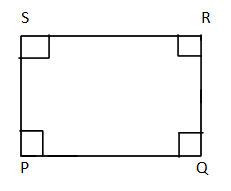
Answer
465.6k+ views
Hint: We all know that if both the opposite sides are equal and parallel, then it will be a parallelogram. There is one more property of parallelogram that opposite angles are equal and we know that in rectangle all the angles are equal to $90^\circ $
Complete step-by-step answer:
So we know that the parallelogram must have opposite sides equal and parallel and also that the opposite angles must be equal then we can say that the given it is a parallelogram.
For example:

For $ABCD$ to be a parallelogram, anyone theorem must have to satisfy:
(1) $AD\parallel BC{\text{ and }}AB\parallel DC$
(2) $AD = BC,AB = DC$
(3) $\angle A = \angle C,\angle B = \angle D$
If anyone of the above three statements are equal then the quadrilateral is a parallelogram.
Now we know that in the rectangle, opposite sides are equal and all the angles are equal to $90^\circ $.
For example: $PQRS$ is a rectangle.

For rectangle:
$\angle P = \angle Q = \angle R = \angle S = 90^\circ $
All angles are equal to $90^\circ $.
So now we know that $\angle P{\text{ and }}\angle {\text{R}}$ are equal to $90^\circ $.
So we can say that $\angle P{\text{ and }}\angle {\text{R}}$ are equal.
We also know that $\angle Q{\text{ and }}\angle S$ are also equal to $90^\circ $.
So we can say that $\angle Q = \angle S$
So opposite angles are equal in rectangle so it is a parallelogram.
Note: It must be known that every square, rectangle are a parallelogram but every parallelogram may or may not be rectangle or square.
Complete step-by-step answer:
So we know that the parallelogram must have opposite sides equal and parallel and also that the opposite angles must be equal then we can say that the given it is a parallelogram.
For example:

For $ABCD$ to be a parallelogram, anyone theorem must have to satisfy:
(1) $AD\parallel BC{\text{ and }}AB\parallel DC$
(2) $AD = BC,AB = DC$
(3) $\angle A = \angle C,\angle B = \angle D$
If anyone of the above three statements are equal then the quadrilateral is a parallelogram.
Now we know that in the rectangle, opposite sides are equal and all the angles are equal to $90^\circ $.
For example: $PQRS$ is a rectangle.

For rectangle:
$\angle P = \angle Q = \angle R = \angle S = 90^\circ $
All angles are equal to $90^\circ $.
So now we know that $\angle P{\text{ and }}\angle {\text{R}}$ are equal to $90^\circ $.
So we can say that $\angle P{\text{ and }}\angle {\text{R}}$ are equal.
We also know that $\angle Q{\text{ and }}\angle S$ are also equal to $90^\circ $.
So we can say that $\angle Q = \angle S$
So opposite angles are equal in rectangle so it is a parallelogram.
Note: It must be known that every square, rectangle are a parallelogram but every parallelogram may or may not be rectangle or square.
Recently Updated Pages
10 Examples of Evaporation in Daily Life with Explanations

10 Examples of Diffusion in Everyday Life

1 g of dry green algae absorb 47 times 10 3 moles of class 11 chemistry CBSE

If the coordinates of the points A B and C be 443 23 class 10 maths JEE_Main

If the mean of the set of numbers x1x2xn is bar x then class 10 maths JEE_Main

What is the meaning of celestial class 10 social science CBSE

Trending doubts
Fill the blanks with the suitable prepositions 1 The class 9 english CBSE

Which are the Top 10 Largest Countries of the World?

How do you graph the function fx 4x class 9 maths CBSE

Who was the leader of the Bolshevik Party A Leon Trotsky class 9 social science CBSE

The Equation xxx + 2 is Satisfied when x is Equal to Class 10 Maths

Differentiate between homogeneous and heterogeneous class 12 chemistry CBSE

Difference between Prokaryotic cell and Eukaryotic class 11 biology CBSE

Which is the largest saltwater lake in India A Chilika class 8 social science CBSE

Ghatikas during the period of Satavahanas were aHospitals class 6 social science CBSE




